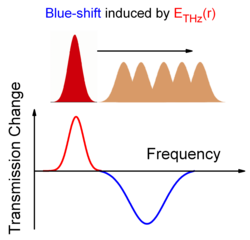Based on its physiological activity, aspirin has found widespread pharmaceutical application in different medical areas. Looking at an individual aspirin molecule from the physics perspective, one can distinguish two types of motions: (i) molecular vibrations, i.e., oscillatory motions of the atomic nuclei in a wide frequency range, among them, e.g., the hindered rotation of the methyl group (Movie 1) at a frequency of 6 terahertz (THz) (1 THz = 1,000,000,000,000 oscillation cycles per second) and (ii) oscillatory motions of electrons in the molecule around 1000 THz (Movie 2), as induced, e.g., by ultraviolet light. While the different motions are only weakly coupled in a single aspirin molecule, they develop a very strong electric interaction in a dense molecular packaging such as in the aspirin tablets from the pharmacy. As a result, the character of particular vibrations, the so-called soft modes, changes and their oscillation frequency is substantially reduced (Movie 3). This complex coupling scheme and the resulting molecular dynamics are important for how aspirin and other molecules respond to an external stimulus. So far, this problem has remained unresolved.
In the current issue of Physical Review Letters, researchers from the Max Born Institute in Berlin and the University of Luxembourg combine top-notch experimental and theoretical methods to unravel the basic properties of soft modes. In the experiments, a sequence of two phase-locked THz pulses interacts with a 700-μm thick tablet of polycrystalline aspirin. The electric field radiated by the moving atoms serves as a probe for mapping the soft-mode oscillations in real time. Two-dimensional scans in which the time delay between the two THz pulses is varied, display a strong nonlinearity of the soft-mode response in aspirin crystals. This nonlinearity is dominated by a pronounced transient shift of the soft mode to higher frequencies (Fig. 1). The response displays a non-instantaneous character with picosecond decay times originating from the generated electric polarization of the crystallites. During the polarization decay, the soft-mode frequency returns gradually to the value it had before excitation.
